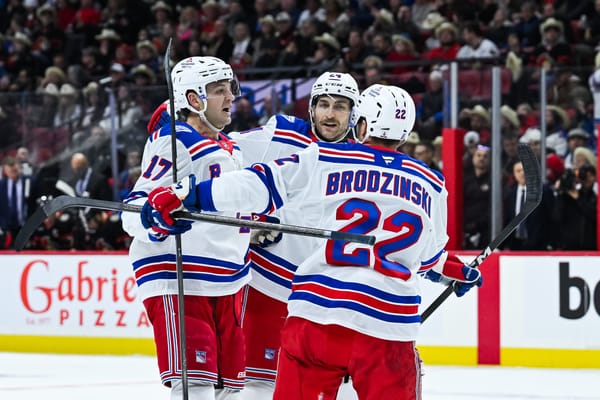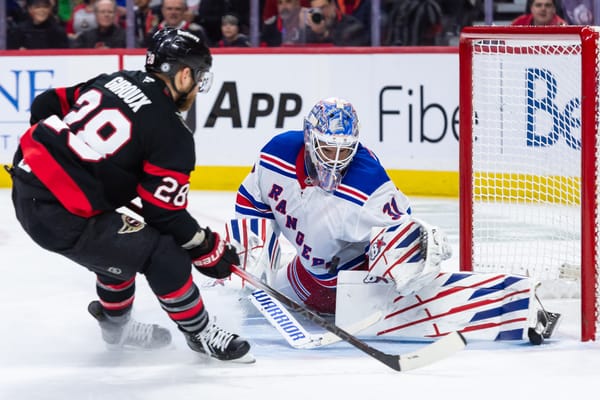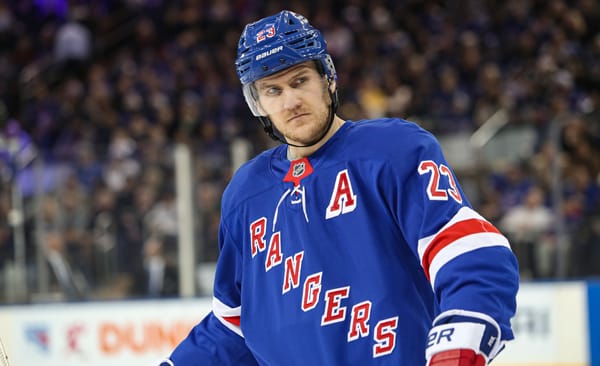Pavel Buchnevich Needs to Make the Most of Golden Opportunity He’s Earned
The Rangers’ winger is in a prime position to have an amazing season.
“Great moments are born from great opportunity...,” and Pavel Buchnevich will start the 2019-20 season with the ability to have a lot of great moments after being given the tremendous opportunity to be the third musketeer on the new top line featuring Artemiy Panarin and Mika Zibanejad.
Head coach David Quinn could have went in a number of different directions. Even though he holds the belief that young players need to earn their opportunities, no one would have batted an eye had he paired Kaapo Kakko with the team’s top two offensive players to make his introduction to the NHL a lot easier.
But that didn’t happen. Instead, Buchnevich is the first man up in what could be a make or break moment for his young career. That seems like hyperbole, but if there were ever an opportunity for the 24-year-old to show what he can do, this is it, chief.
The biggest reason is that in terms of right wing depth Buchnevich will likely be passed by Kakko in the next 12 to 18 months if not before that — which isn’t bad for the team, or even Buchnevich — and he could eventually be passed by 2018 No. 9 overall pick Vitali Kravtsov. That means the clock is ticking for him to show that he can be a top-six forward on a contending team.
If Buchnevich is unable to do this, once his contract runs out the rebuilding Rangers — who ideally are much closer to a contending team at that point — won’t have much use for him in a third-line role based on what he could be looking for in both term and salary. In some respects, this is a somewhat similar situation to the Panarin signing, and the impact it has on Chris Kreider. Adding Panarin to the team bumped Kreider into a second-line role, and with him slated to hit free agency the Rangers need to evaluate what he’s worth financially based on the role he’ll hold with the team.
If all goes to plan the Rangers could have a deep trio of wingers on the right with Buchnevich, Kakko, and Kravtsov. But such a situation would mean all are exceeding expectations, and would command a decent salary. There’s also the potential that someone changes positions — a real possibility if Kreider does depart the franchise — and Buchnevich would still have a spot in the top six. Overall I don’t want to project out that far, but it is something worth thinking about.
Over the last few years I’ve written a lot about Buchnevich, and been a staunch supporter who has felt he’s not been given all the opportunities he’s deserved. The talent has always been visible, and the main issue was consistency although streakiness is something that impacts all players. But in this league if you want to get the ice time of a top player and paid like one, at some point the rubber needs to meet the road.
Most of that came during Alain Vigneault’s time in New York, and after the coach was let go Buchnevich talked about a number of topics including how confidence played a role in his game, and how communication between him and his former bench boss wasn’t great.
That changed for the better overall under Quinn, and the results speak for themselves. Buchnevich’s second half was better than his first, and some of that has to do with the opportunity he was given in 2019.
Related
Pavel Buchnevich Should Be Given Bigger Opportunity in Second Half of Season
The 2018-19 campaign was Buchnevich’s second full season, as his true rookie season was just 41 games. He posted career bests in goals (21), points per game (0.59), and average ice time (15:10). His end to the season was strong, and something that played a role in him being the first player to skate on a line with Panarin and Zibanejad.
Via Colin Stephenson of Newsday:
I think ‘Buchie’ had a really good last two months of the (2018-19) season, and we certainly want to build off the way his season ended,’ Quinn said. And I think he deserves that opportunity.’
He’s getting that chance now, and it comes fresh off him signing a two-year bridge deal worth $3.25 million a season. Buchnevich is betting on himself, and if all goes to plan he will tear it up and get to a point where his agent can channel his inner Teddy KGB and tell Jeff Gorton to...
But before that, I think it is important to look at the situation Buchnevich is entering, and what he will need to do to be successful and have a major impact.
Making the Most of The Opportunity
The dynamic of the Rangers’ new top line (PZB for now, although there’s assuredly a name that will emerge) is going to be interesting, and for Buchnevich to make the most of his newfound opportunity he’ll need to shoot the puck more. He’s going to be playing with two forwards who equally like scoring goals and helping others score, and Buchnevich has got to take more shots.
Before getting into the specifics, here’s a look at Buchnevich 5v5 throughout his career by season just so you have a sense of the shots he’s taken; the ones that have gone in, have missed, been saved etc. Overall, it’s a little light; ideally you’d want to see a lot more markings.
You can run cool stuff like this by supporting Micah Blake McCurdy at HockeyViz.com
In his career of 179 games to date, Buchnevich has scored 43 goals on 310 shots (13.87%). That breaks down to just 1.73 shots per game which is a pretty low number. When looking at just 5v5 situations, Buchnevich has tallied 26 goals on 232 shots (11.21%), which divides down to 1.29 shots per game, or 0.44 fewer shots per game than his all situations number.
Last season he took 119 shots in 64 games which is 1.86 shots per game on average, which ranked seventh-most on the Rangers. Zibanejad led the team at 2.88 shots per game, and Chris Kreider finished second at 2.54.
Of those 119 shots, 91 were taken 5v5 which breaks down to 1.42 shots per game (0.44 fewer shots per game vs. all situations total), or 10th most among all Blueshirts. For context, Kreider occupied the top spot with 1.84 shots per game, and Zibanejad came in second with 1.70.
So the first question that may come to mind is, why are his shot totals so low? To that I’m inclined to say that Buchnevich hasn’t had as many opportunities to shoot the puck, and when I say opportunities I specifically mean getting the minutes to do so. But overall there’s more to it than that.
Buchnevich ranked eighth among forwards and 14th overall in total minutes last season, skating just 804:37 5v5. When you sort go by ATOI per game, Buchnevich’s 12:34 comes in seventh among forwards and 15th overall. In order to score you not only need to shoot, but get on the ice, and that didn’t happen as much for him.
That’s not going to be an issue to start the season, as he should skate roughly 18:00 a game on the top line. So while minutes could have played a role in the past, there’s also the fact that Buchnevich likes to pass, sometimes to his own detriment. There have been numerous times in the pass-first winger’s career in which he’d be in a perfect shot to shoot, but at the last minute he’d defer to someone else.
That’s something that a number of Rangers have done in recent years, as the team had lacked players who’d actually shoot the puck with frequency. However, Buchnevich is one of the biggest offenders of passing up shots, and that has to change.
Buchnevich’s proclivity for passing has led to him tallying 58 assists in 179 games, and when broken down by season he’s finished with rates of 0.29, 0.39, and 0.27 per game. This is not to say that being a playmaker is a bad thing or that his passing ability won’t come in handy given Panarin and Zibanejad’s proficiency to score goals, but they also have an elite playmaking acumen — so, to keep up and round out his game, Buchnevich has to shoot more.
This year both will aim to keep the opposition on their toes, and constantly thinking about whether they will shoot or pass. And with Buchnevich being the lone lefty on the line, there’s bound to be a plentiful number opportunities for Panarin and Zibanejad to feed him the puck for one timers. While playing with both should help him increase his counting stats, there’s also the opportunity for him to learn how to balance the concept of shooting the puck while also being able to thread the needle when setting up his teammates.
For example, Panarin’s scored 116 goals on 817 shots (14.20%) in 322 games, and averages 2.53 shots per game. At 5v5 his numbers include 69 goals on 565 shots (12.21%) and his shot rate was 1.75 per game (0.78 fewer shots per game vs. all situations).
Here’s his shot chart 5v5 over the last three years for you have something to compare to Buchnevich’s chart.
This chart is a little more cluttered, and that highlights Panarin’s ability to get shots off and create havoc. This is on the high end of things in terms of Ranger forwards, and something Buchnevich can strive for in the future. Obviously shot quality matters over shot quantity, but as you saw in the GIF above, Buchnevich certainly has a tendency to pass up shots.
A lot has been written about the subject of shot quality, and there are a number of pieces over at Hockey-Graphs, and you can find them all here. I don’t think Buchnevich will ever be a high volume shooter, and the best way to sum up what I am suggesting is that he needs to adjust his tendencies heading into the season playing on this line.
But in general, I can say I agree with Beth here in most situations when he has the puck.
Buch, honey, SHOOT THAT
— Beth Boyle Machlan (@bethmachlan) March 5, 2017
Back to Panarin, in addition to his ability to score goals, he’s an adept playmaker who has finished with 43 or more assists in each of his four seasons in the NHL, with a total of 204 to date.
Zibanejad has had equally positive results — although he’s been more of a scorer — and has tallied 135 goals on 1,156 shots (11.68%) in 491 games. He also averages 2.35 shots per game in all situations. During 5v5 play, he’s tallied 76 goals on 772 shots (9.84%) while averaging 1.57 shots per game.
He’s also tallied 174 assists in all situations, and finished with a career-high 44 helpers last season. The Rangers’ first line center scored 30 goals for the first time in his career, and skated 20:34 which was another career high.
Interestingly enough, both Panarin and Zibanejad have taken 0.78 fewer shots 5v5 than they have in all situations, and have still posted some respectable goal totals while being good playmakers. They are able to do this because they still take a lot of shots overall.
The goal for Buchnevich should be record at least 165 shots on goal this season which would be an average of 2.01 shots per game if he dressed for all 82 games. Career to date he’s taken 75% of his total shots in 5v5 situations, so that would be about 124 5v5 shots. Obviously more is better, but I don’t think someone with a career high of 136 shots in a season is going to make a jump to over 200 in one year. A total of 165 shots would be an increase of 29 shots versus his career high, which feels like a reasonable number.
But the clear TL/DR here is to take...
The best way to wrap up this story is by including this section from the end of Buchnevich’s 2019 Report Card.
This season a number of forwards took a next step forward under David Quinn, and Buchnevich was one of them. Quinn was impressed with how Buchnevich progressed, and it sets up a situation for the Rangers’ young winger to get off on the right foot at the start of the 2019-20 season.
Quinn deserves credit for the approach he took to get the most out of Buchnevich — one that involved consistent communication, unlike the tactics employed by his predecessor. Still, there was already evidence that showed what Buchnevich was capable of before this season and approach.
Prior to suffering a concussion last season, Buchnevich was on the right track with 32 points in his first 50 games. He would end the season with 43 points, and that left fans wondering “what if?” Next season there’s a chance that the winger group involves Vitali Kravtsov and Kaapo Kakko, and it’ll be interesting to see where he slots in the lineup.
The talent has always been there for Buchnevich, as evidenced by 32 points in his first 50 games during a 2017-18 season which was derailed by a concussion. Had he not suffered that injury, I think he would have ended up with more than 43 points based on how well he was skating.
But the positive to take away is that last season he reached a career highs, got on the same page with his coach, and was able to play the game fully understanding what was expected of him, while not having to fear making a mistake. And that performance and understanding helped lead to Quinn choosing him to skate on the top line to start the season.
Another element is something that Zibanejad brought up in recent media availability, and it is the concept of growth and maturity.
The question starts at the 3:42 marking above, and he touches on his development last season and how thus far in camp Buch seems like a more mature player. The word mature could be interpreted many ways, whether it be physically or emotionally, and it could be a combination of both given the forward’s history of wearing his emotions on his sleeve face which I’ve affectionately referred to as his “Resting Buch Face.”
#RestingBuchFace #NYR pic.twitter.com/2nSK6mYfR0
— Tom Urtz Jr. (@TomUrtzJr) March 3, 2018
Everything is right in front of Buchnevich, and he simply has to grab the brass ring. He has the talent, he’s going to be given the ice time he’s never really gotten, and will be playing with two immensely talented players.
Now is the time for Buchnevich to show what he’s truly capable of, and if he’s going to be a 20-goal player who flirts with 50 points his entire career, if he’s someone who can push for 30 goals and close to 60 points, or if he’s a player who will just fall short of that. One way or another, we’ll find that out this season, and whether it be a success or failure; it will all be on Buchnevich.
Stats via Hockey-Reference and Natural Stat Trick unless otherwise noted.





